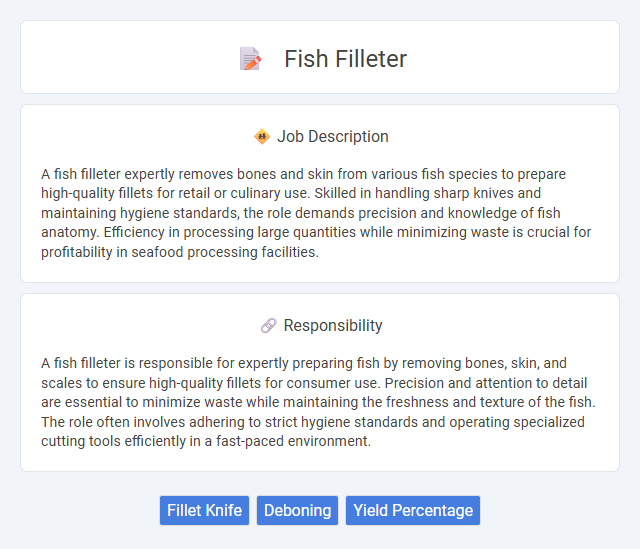
A fish filleter expertly removes bones and skin from various fish species to prepare high-quality fillets for retail or culinary use. Skilled in handling sharp knives and maintaining hygiene standards, the role demands precision and knowledge of fish anatomy. Efficiency in processing large quantities while minimizing waste is crucial for profitability in seafood processing facilities.
Fish filleter jobs probably suit individuals with good hand-eye coordination and strong attention to detail due to the precision required in filleting. People who can stand for long periods and work in cold, wet conditions likely find this job manageable, while those sensitive to repetitive motion or uncomfortable environments may struggle. Physical stamina and comfort with handling raw fish increase the likelihood of success in this role.
Qualification
A fish filleter must have strong knife skills and in-depth knowledge of fish anatomy to efficiently separate fillets from bones without damaging the meat. Experience working in seafood processing environments and familiarity with hygiene standards and safety regulations are essential qualifications for maintaining product quality and preventing contamination. Physical stamina and attention to detail enhance precision and productivity in this repetitive, labor-intensive role.
Responsibility
A fish filleter is responsible for expertly preparing fish by removing bones, skin, and scales to ensure high-quality fillets for consumer use. Precision and attention to detail are essential to minimize waste while maintaining the freshness and texture of the fish. The role often involves adhering to strict hygiene standards and operating specialized cutting tools efficiently in a fast-paced environment.
Benefit
Working as a fish filleter likely offers benefits such as skill development in precision cutting and handling seafood, which can enhance employability in the food processing industry. There may be opportunities for steady employment, especially in regions with high demand for fresh fish products. The role probably provides a physically active work environment, contributing to overall fitness and job satisfaction for those who enjoy manual tasks.
Challenge
Working as a fish filleter may present challenges related to precise knife skills and maintaining speed while ensuring minimal waste. There is a likelihood of physical strain from repetitive motions and long hours standing in cold, wet environments. Attention to detail might be critical to meet quality standards and avoid product loss.
Career Advancement
A Fish Filleter position offers valuable hands-on experience in seafood processing, enhancing skills in precision and speed essential for career growth. Mastery in filleting techniques can lead to supervisory roles or specialization in quality control within the fisheries industry. Opportunities for advancement often include transitioning into seafood processing management or technical training instructor positions.
Key Terms
Fillet Knife
A fish filleter relies heavily on a high-quality fillet knife to efficiently separate fish flesh from bones while minimizing waste. Precision-crafted fillet knives feature thin, flexible blades designed to navigate the contours of various fish species, ensuring clean cuts and maintaining the integrity of delicate meat. Mastery of fillet knife techniques directly impacts product yield and customer satisfaction in commercial and artisanal fish processing environments.
Deboning
Fish filleters specialize in deboning by expertly removing bones from various fish species, ensuring a clean, boneless product ideal for cooking or processing. Precision and thorough knowledge of fish anatomy are crucial to minimize waste and maintain the fillet's integrity. Advanced deboning techniques enhance product quality, leading to higher customer satisfaction and value in the seafood market.
Yield Percentage
Fish filleters play a crucial role in maximizing yield percentage by skillfully removing fillets from whole fish with minimal waste. High yield percentages directly impact profitability in seafood processing by ensuring more product is available for sale from each fish. Techniques such as precise cutting, proper handling, and understanding fish anatomy significantly enhance yield outcomes in fish filleting operations.
 kuljobs.com
kuljobs.com